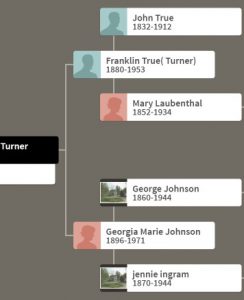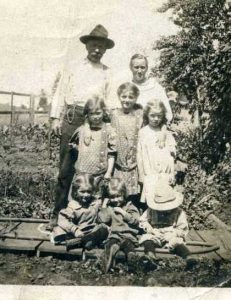 In sorting out a DNA match recently, I uncovered a rather puzzling family story. On 23andme, my father’s closest “stranger match” was a person I will call “J.O.H.” She and my father shared 0.83% DNA along 5 DNA segments, for a total of 62 centimorgans, with a predicted kinship of third cousins. The only people my father had more DNA in common with were myself, my daughter, and one known second cousin once removed though his paternal grandfather. Another known second cousin once removed, also through my father’s paternal grandfather, had less DNA in common with my father than my father had with J.O.H. Both of these known cousins were not related to this stranger match, leading me to conclude this match should be through my father’s paternal grandmother [from Massachusetts], or through my father’s mother [from Pennsylvania]. Continue reading Through the wringer
In sorting out a DNA match recently, I uncovered a rather puzzling family story. On 23andme, my father’s closest “stranger match” was a person I will call “J.O.H.” She and my father shared 0.83% DNA along 5 DNA segments, for a total of 62 centimorgans, with a predicted kinship of third cousins. The only people my father had more DNA in common with were myself, my daughter, and one known second cousin once removed though his paternal grandfather. Another known second cousin once removed, also through my father’s paternal grandfather, had less DNA in common with my father than my father had with J.O.H. Both of these known cousins were not related to this stranger match, leading me to conclude this match should be through my father’s paternal grandmother [from Massachusetts], or through my father’s mother [from Pennsylvania]. Continue reading Through the wringer
Monthly Archives: May 2017
A woman’s nationality

Between 2 March 1907 and 22 September 1922, the Expatriation Act of 1907 required a woman who married a foreigner to take the nationality of her husband, and therefore she lost her own citizenship. The Cable Act (also known as the “Married Women’s Independent Nationality Act” or the “Married Women’s Act”) passed on 22 September 1922; it repealed the 1907 law and thus severed a woman’s marital status from her husband’s nationality. Continue reading A woman’s nationality
Birth marks

We family historians can never get enough of a good thing, right? So in the fall of 2012 when my son and his fiancée tied the knot I was thrilled for two very different reasons: a) my new daughter in-law was going to be an awesome addition to the family, and b) with it she was bringing an entirely new family history for exploring – a welcome relief after staring at my own brick walls for too long.
Before long, I was in the thick of researching her family tree, especially those lines that would lead (where else but?) to New England. Soon enough I could see a possible Mayflower line in her grandmother’s Martell family. There seemed to be a clear path to Mayflower passenger Henry Samson. And while I wasn’t intent on signing up my new daughter-in-law for the GSMD, I knew I had to be able to prove this for my own benefit – and for any future grandchildren (wink). Continue reading Birth marks